This blog by Siena Chrisman was originally posted March 18, 2020, at www.dairytogether.com.
The US-Mexico-Canada Agreement (USMCA), or NAFTA 2.0, was signed into law by President Trump in January, following more than a year of contentious wrangling by many politicians and interest groups. The deal, which updates the 1994 North American Free Trade Agreement, has been touted by the agriculture industry as a big win for farmers, but the reality is that its farm provisions will lock in the status quo for farm country. Especially in dairy, USMCA fails to deliver on big promises.
Dairy was one of the main sticking points as the deal was negotiated. As members of the Dairy Together network know, Canada has a largely successful dairy supply management program, which provides farmers a fair price for their milk and protects them from the volatile price swings that are all too familiar to US dairy farmers. The US government, however, calls supply management “protectionist,” and has lobbied to open Canada’s dairy market to US exports, since without market management, we have a flood of surplus milk in search of a market. The US already exports $1.6 billion of dairy products to Canada, but the US dairy industry would like to increase that total.
In the USMCA, US negotiators were partly successful in opening the Canadian dairy sector, levering a now-common threat of imposing tariffs against Canadian manufacturing. The new agreementallows the US to ship more dairy products to Canada, including up to 50,000 metric tons of fluid milk by the sixth year of the deal. Canada has also agreed to end what’s called Class 7 pricing, created in 2017 to lower prices of some Canadian-produced milk ingredients, which made the American equivalents uncompetitive. Ending Class 7 pricing is anticipated to create an additional market for American products like milk protein concentrate (MPC), skim milk and whole milk powder.
However, these byproducts already flow both ways over the border with no requirement that the cheese, yogurt, and many other food products that contain them be labeled. Some dairy advocates point to the under-interrogated issue of how MPC use disrupts the milk pricing structure in the US by greatly extending cheese yields and creating oversupply. If US cheese companies and others make their products with Canadian MPC and other inexpensive byproducts rather than with US milk, it displaces protein components, thus further skewing the milk price. The USMCA does nothing to address these concerns or limit the increasing consolidation and vertical integration in the US dairy industry.
In the industry enthusiasm about opening the Canadian market, the actual size of the reforms is rarely mentioned. The US dairy market is four times that of Canada’s. US dairy farmers underwater from five years of low prices will gain little from access to such a small additional market. In fact, the industry’s own materials cite the largest possible gain for the sector as $280 million—a tiny fraction of the current $1.6 billion Canadian dairy export market.
And the meager benefits aren’t just in dairy: the US International Trade Commission (USITC) estimates that, across the board, the projected gains for US agricultural exports to Canada under the USMCA are just $450 million, along with 1,700 new agricultural jobs over the full period of the deal’s implementation. With gains this small, the deal amounts to a race to the bottom that will displace Canada’s dairy farmers for only minimal benefits to American dairy farmers.
As this situation illustrates, the USMCA does little to address agricultural dumping—that is, exporting goods at prices below the cost of production. Following the passage of NAFTA, corn imports into Mexico rose from 2 million to over 10 million tons, mostly coming from US agribusiness firms. The flood of corn drove 2.5 million Mexican farmers and farm workers off their land and devastated an economy and national diet based on corn. According to the World Bank, extreme rural poverty in the country jumped from 35 percent to 55 percent in the four years after NAFTA. US farmers did not benefit from the opening of the Mexican market: in the same period, the US lost nearly 250,000 family farmers. With no anti-dumping provisions in the USMCA, the practice will continue, this time undercutting our dairy farmer neighbors to the north with low-cost US imports.
In another disappointment for farmers, the USMCA does not reinstate Country of Origin Labeling (COOL), which farmers have been advocating for decades. COOL was passed in the 2002 farm bill and revoked following a 2015 WTO complaint from Canada. Many farmers and advocates saw the renegotiation of NAFTA as an opportunity to leverage US power with Canada and Mexico to reinstate the popular labeling law for meat and expand it to dairy products. Other governments with comparable dairy industries have made significant policy efforts to protect their family dairies by promoting strict national, and even regional, labeling initiatives. The lack of COOL disadvantages US farmers and keeps consumers in the dark, but US negotiators, at the urging of the corporate dairy industry, did not make the effort to reinstate COOL in the USMCA.
In other areas, USMCA makes some modest improvements over NAFTA and previous proposals, including elimination of the undemocratic investor-state dispute settlement (ISDS) arbitration procedure, which allows corporations to sue governments for environmental and labor protections they see as unfair to business. USMCA also includes some stronger labor standards, particularly for Mexican unions, which are sorely needed as Mexican labor activists routinely face violence for their efforts to defend workers’ rights. But these changes will not stem the flow of manufacturing jobs out of rural America. The disappointing results for farmers, rural communities, and working families throughout North America remind us that massive trade agreements should not be negotiated behind closed doors. Future trade agreements must be negotiated openly and with public input, to ensure a fair deal for all.

